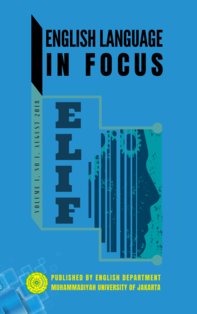The Effectiveness of Morphological Analysis Technique in Teaching Vocabulary
DOI:
https://doi.org/10.24853/elif.1.1.9-22Keywords:
morphological analysis, root, prefix, suffix.Abstract
The purpose of the study was to investigate the effectiveness of Morphological Analysis technique in teaching vocabulary at SMPN 13 Kota Tangerang Selatan, Banten. The design of the study was quasi-experimental. The samples were 76 students of the 8th grade who were taken randomly using purposive random sampling. The samples were classified into two groups: 39 students in the experimental group and 37 in the control one. The data collected through a pretest and a posttest which had been proved valid and reliable by ANATES. In between, the teaching of 20 prefixes and 20 suffixes were done in both groups but with a higher frequency of occurrence in the experimental class. The finding showed that the experimental group got a higher mean score than the control one, and the statistical calculation found that there was a significant difference between the mean scores of the two groups. It indicated that the morphological analysis technique is effective to teach vocabulary to the 8th-grade students of SMPN 13 Kota Tangerang Selatan, Banten.References
Allen, J. (2007). Inside Words : Tools for Teaching Academic Vocabulary, Grades 4-12. Portland: Stenhouse Publishers.
Anglin, J. M., Miller, G. A., & Wakefield, P. C. (1993). Vocabulary Development: A Morphological Analysis. Monographs of the Society for Research in Child Development, 58(10), 1-186. https://doi.org/10.2307/1166112
Chacón Beltrán, R., Abello-Contesse, C., & Torreblanca-López, M. del M. (2010). Insights into Non-Native Vocabulary Teaching and Learning. Bristol: Multilingual Matters.
Gairns, R., & Redman, S. (1986). Working with Words : A Guide to Teaching and Learning Vocabulary. Cambridge: Cambridge University Press.
Hanson, S., & Padua, J. F. M. (2011). Teaching Vocabulary Explicitly. Mariana: Pacific Resources for Education and Learning.
Harmer, J. (1996). The Practice of English Language Teaching. New York: Longman.
Katamba, F., & Stonham, J. T. (2006). Morphology. Hampshire: Palgrave Macmillan.
Lieber, R. (2012). Introducing Morphology. Cambridge: Cambridge University Press. https://doi.org/10.1017/cbo9780511808845
White, T. G., Power, M. A., & White, S. (1989). Morphological Analysis: Implications for Teaching and Understanding Vocabulary Growth. Reading Research Quarterly, 24(3), 283-304. https://doi.org/10.2307/747771
White, T. G., Sowell, J., & Yanagihara, A. (1987). Teaching Elementary Students to Use Word-Part Clues. The Reading Teacher, 42, 302–308. https://doi.org/10.2307/20200115
Wysocki, K., & Jenkins, J. R. (1987). Deriving Word Meanings through Morphological Generalization. Reading Research Quarterly, 22(1), 66-81. https://doi.org/10.2307/747721
Downloads
Published
Issue
Section
License
Authors who publish with this journal agree to the following terms:
- Authors retain copyright and grant the journal right of first publication with the work simultaneously licensed under a Creative Commons Attribution License that allows others to share the work with an acknowledgment of the work's authorship and initial publication in this journal.
- Authors can enter into separate, additional contractual arrangements for the non-exclusive distribution of the journal's published version of the work (e.g., post it to an institutional repository or publish it in a book), with an acknowledgment of its initial publication in this journal.
- Authors are permitted and encouraged to post their work online (e.g., in institutional repositories or on their website) before and during the submission process, as it can lead to productive exchanges, as well as earlier and greater citation of published work (See The Effect of Open Access).


